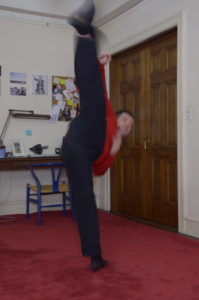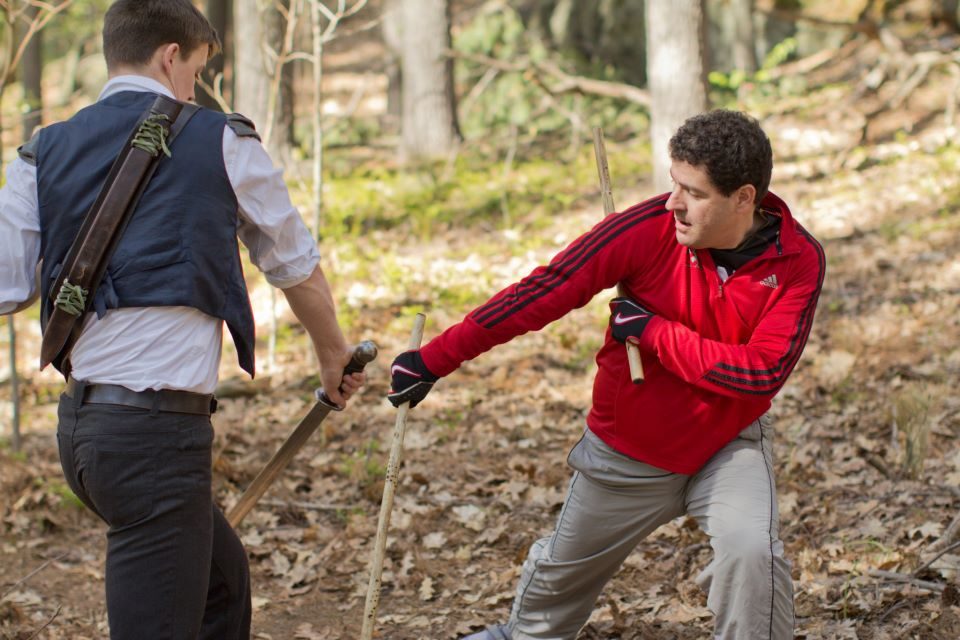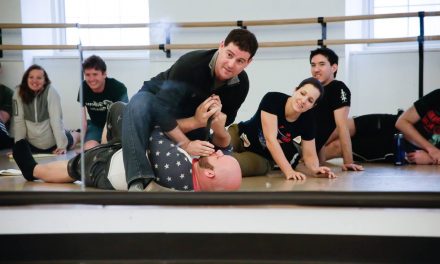Surprisingly, in the early stages of studying stage combat, a martial arts background is often an obstacle before it becomes an asset. I write this not only as a fight director, but as a lifelong martial artist and former competitive fencer. While I found my martial arts background to be an invaluable asset in my fight directing career, there are several things I wish someone had pulled me aside and told me early on.
These words of advice are aimed at those coming into stage combat with a strong martial arts background but with little theatrical experience. They come from both having taught stage combat to students with extensive martial arts background as well as from my personal experience early in my own training.
This is primarily concerned with orienting oneself to common theatrical practices as per The Society of American Fight Directors, British Academy of Stage and Screen Combat, Fight Directors Canada and the like. If you are cast in a Tony Ja or Jackie Chan movie, obviously you’re playing by different rules.
1) It will be important to learn to compartmentalize your prior training. This is especially true early on. The biggest difference is that you are working with a partner to safely create an illusion for the benefit of an audience/camera, as opposed to working against an opponent within structured rules of engagement. I’ve said many times that stage combat more closely resembles a combination of ballroom dance and sleight of hand than any actual fighting system.
2) Many of the skills and techniques you learn in stage combat will be extremely counterintuitive. Much of what you will be instructed to do may feel uncomfortable. For example, if you were a competitive fencer, even something as fundamental as the stance for stage fencing will make you feel vulnerable. Keep in mind that the movement vocabulary you are developing has an entirely separate purpose from your previous experiences. Additionally, in fight choreography, performers may be directed to show the pain and/or injuries that their characters are feeling. This is counter to the stoicism in many martial arts traditions. Remember that you are learning an aspect of acting more than you are learning another way of fighting.
3) The reflexes and training that you may have spent years developing and perfecting will get in your way at first. For example, blocking a choreographed blow will have a fraction of the energy that a block would carry in a hard style. If you’ve spent years developing speed and power, putting that aside for an activity that feels just enough like martial arts training to confuse your muscle memory will be no small task.
4) If you are not careful, you can, in fact, be a danger to your partners. Working with a fellow stage combat student is not the same as working with a martial arts partner who is junior to you. The expectations and goals are different, and if you have any risk of defaulting to prior training, you become a risk to your partners.
5) By the same token, do not take unnecessary risks. Things to avoid are harder contact blows, risky falls on hard surfaces, or anything else that might result in injury. A martial arts background does not make you immune to injury.
6) Many martial arts subcultures have a certain indoctrination of “how things are done.” Adapt beyond this. It is another element that can cause confusion when learning stage combat. Endeavor to keep an open mind. Being a sterling example of your system/lineage’s technical proficiency does not necessarily translate into safe and aesthetically effective stage technique.

The author kicking for the camera on set after choreographing fights for Honk! Honk! The Movie
7) Slow down. Speed and power are not your friends. Especially not power. Remember that you may be partnered in a scene with someone physically fragile and that safety is your first priority. Even if you could do so safely, your top speed is likely to be too fast for an audience member to follow and you would lose narrative clarity. Remember that creating a narrative is the goal and your audience is unlikely to be martial arts enthusiasts.
8) Distances will be different than you are used to and this can be particularly disorienting. The illusion of a blow can occur with a hand or foot much further away than you might suspect. Again, remember that safety and illusion are the priorities. The control that many striking styles develop wherein a practitioner stops a blow within a fraction of an inch of their target is inappropriate for theatrical practice. While, non-martial artists may read that last sentence and wonder why anyone needs to be told that, many Karate & TKD schools make such practices a habit.
9) All that said, once you have assimilated the principles of stage combat and learned to compartmentalize your training, your martial arts background will be an invaluable resource. This can put you miles ahead in terms of body control, simulating aggressive actions, and understanding “fight logic.” Additionally, when it is called for to move faster, you will be comfortable with the speed sooner. Many accomplished fight directors are also accomplished martial artists, and it never hurts to have an additional vocabulary in common. All that said, it may take longer to assimilate the new methodologies than you expect.
This post was written by the author in their personal capacity.The opinions expressed in this article are the author’s own and do not reflect the view of The Theatre Times, their staff or collaborators.
This post was written by Meron Langsner.
The views expressed here belong to the author and do not necessarily reflect our views and opinions.


















